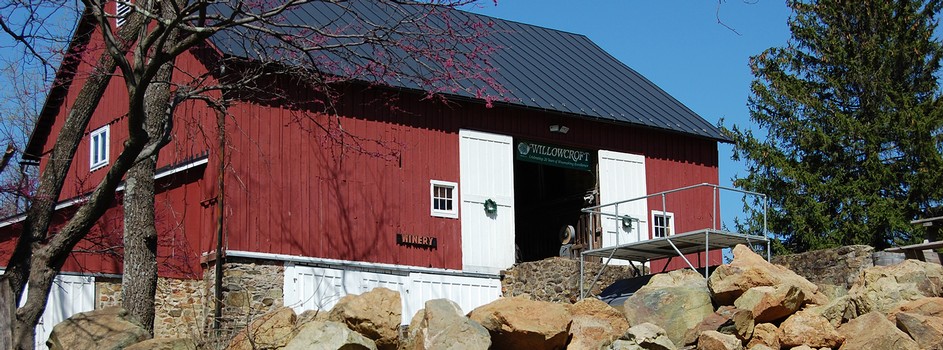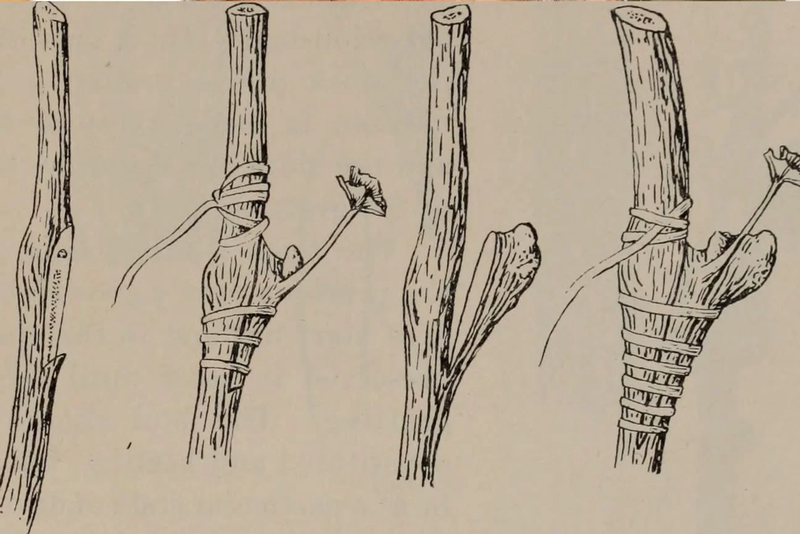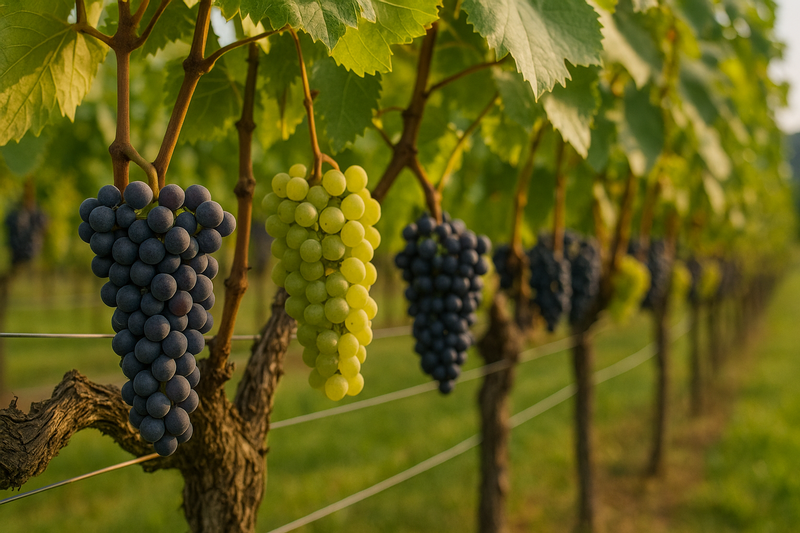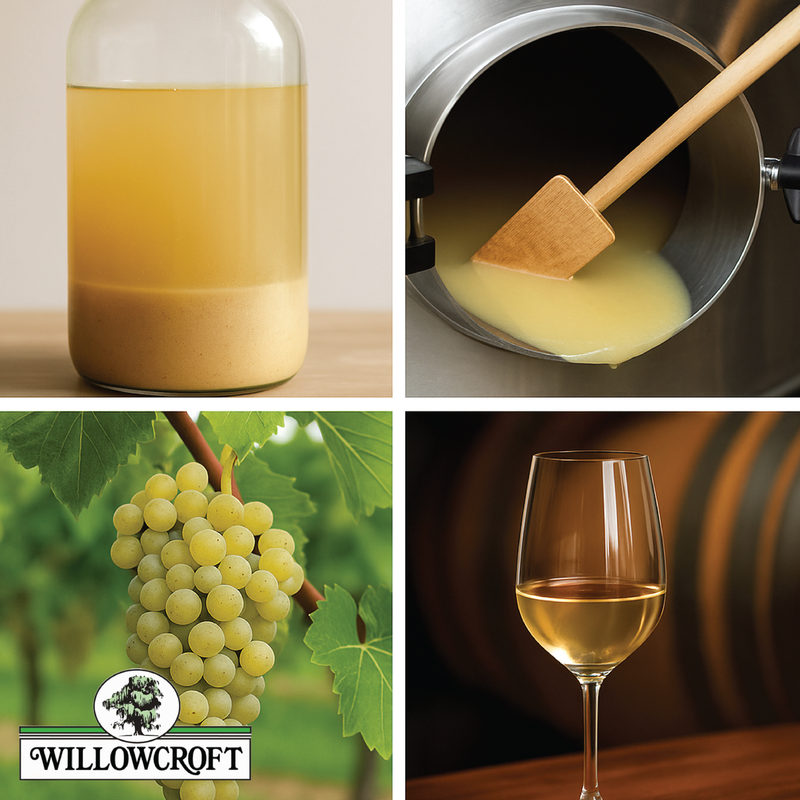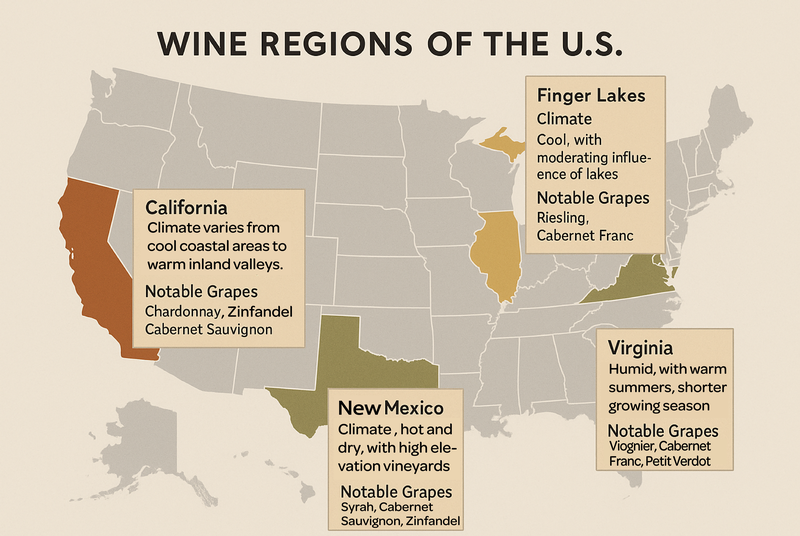News
Welcome to the Willowcroft blog! This is where we will be highlighting events and news from around the winery.
Rootstock Rebellion: How the Bottom Half of the Vine Shapes the Wine
The Unsung Hero Beneath Every Great Vintage
Ask a wine lover to name what shapes a wine’s character, and you’ll hear about grape varieties, climate, barrels—even yeast. But there’s one key player almost no one talks about: rootstocks.
These humble underground structures don’t make headlines or tasting notes, but they’re the very foundation of modern viticulture. They protect against pests, adapt vines to challenging soils, and influence everything from how grapes ripen to how the wine tastes. At Willowcroft, where we farm without irrigation and face Virginia’s humid summers, choosing the right rootstock isn’t optional—it’s vital.
So why don’t we hear more about them? To answer that, let’s dig into history, science, and a little Texas-sized adventure.
In simplest terms, a rootstock is the underground part of the vine—the roots—that’s grafted to the fruiting vine (the part above ground that produces the grapes). The fruiting vine is typically Vitis vinifera, the classic European grapevine species behind beloved varietals like Chardonnay, Cabernet Sauvignon, and Merlot.
The rootstock, however, often comes from other grape species. Why? Because it acts like the engine of growth, protecting vines from pests, diseases, and environmental stress. It also influences vigor, water uptake, nutrient absorption, and even how a grapevine copes with Virginia’s frequent heat and humidity.
Rootstocks became essential during the 19th century when Europe’s vineyards were nearly wiped out by phylloxera, a tiny root-feeding insect native to North America. European vinifera vines had no resistance to the pest. The solution? Grafting them onto American rootstocks, which had evolved alongside phylloxera and developed natural defenses.
The first rootstocks tried—Vitis riparia—thrived in moist, fertile riverbank soils but failed in the dry, calcareous soils of regions like Champagne and Burgundy. Then came Vitis rupestris, better suited to stony soils but still unhappy in limestone-rich areas.
The breakthrough came when botanists like Pierre Viala and Thomas Volney Munson identified Vitis Berlandieri, a Texas native thriving in dry, chalky soils. Though difficult to propagate, Berlandieri became the backbone for hybrid rootstocks like 41B, which saved French vineyards and remains in use today.
Virginia’s climate brings its own set of hurdles for grapevines. Our summers often deliver long stretches of heat and humidity without relief, creating the perfect conditions for fungal diseases like powdery mildew and botrytis. Pair that with dry-farmed hillsides and variable soils, and rootstock selection becomes not just important, but essential.
The right rootstock helps balance vigor, resist disease, and manage water uptake in these demanding conditions. Some, like Petit Verdot’s small, tight clusters, naturally help resist moisture intrusion, but beneath the surface, it’s the rootstock doing much of the heavy lifting.
💡 To better understand how different rootstocks perform, here’s a quick chart showing key rootstock types, their strengths, and where they shine in the vineyard:
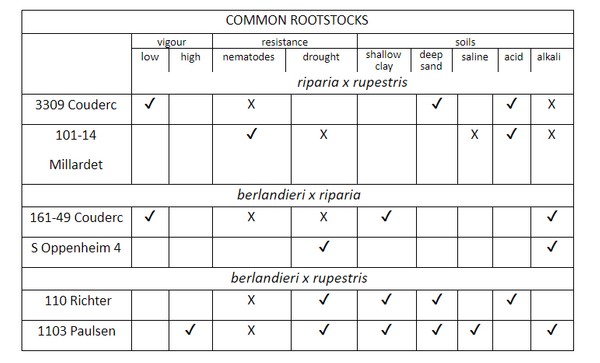
This snapshot helps demystify the role of rootstocks and shows why their selection matters as much as the grape variety grafted above them.
Today, nearly all commercial vineyards rely on rootstocks derived from the same small group of species: vinifera, riparia, rupestris, and Berlandieri. But nature doesn’t stand still. Phylloxera has evolved into numerous biotypes and superclones, while climate change introduces new challenges like extreme drought and shifting soil salinity.
Some researchers are exploring wild Asian grape species for new traits. Others argue for modern methods, including genetic modification (GM), to develop next-generation rootstocks. This remains controversial, but so was grafting American roots to French vines—until it saved the world’s wine industry.
Rootstocks are more than a technicality—they shape:
🌿 Vine vigor and health
💧 Drought tolerance and disease resistance
🍇 Ripening speed and fruit quality
🌱 Sustainability in challenging climates
At Willowcroft, we see them as quiet partners in the vineyard, helping us produce elegant, expressive wines—year after year—even in Virginia’s demanding environment.
So next time you swirl a glass of Petit Verdot or Chardonnay, raise a silent toast to the roots beneath your feet.
Visit Willowcroft for a tasting or tour, and ask us about the vines in your glass. There’s a world of science and history lying just below the soil.
🍇 Grape Clones & Hybrids: What They Are and Why They Matter
A Willowcroft Deep Dive into the Genetics of Great Wine
Not all Chardonnay is created equal.
Not even all Merlot.
In fact, even within the same vineyard block, the grapes growing just a few feet apart might come from entirely different genetic lineages.
Most wine lovers are surprised to learn how much grape genetics influence what’s in their glass. At Willowcroft, we take pride in our deep connection to both classic vinifera grapes—like Cabernet Sauvignon, Cabernet Franc, and Chardonnay, which were among our original plantings—and to modern hybrid varieties that have helped us thrive in Virginia’s unique growing environment.
Understanding how clones and hybrids work is key to appreciating the science and artistry behind every bottle we produce. And no, none of this involves GMOs—so let’s set the record straight.
Clones are genetically identical copies of a single "mother vine" that showed exceptional traits, like superior flavor, disease resistance, or early ripening. Cuttings, not seeds, propagate these vines, allowing them to retain the exact DNA of their origin.
Think of clones as siblings from the same exceptional parent, each expressing slightly different characteristics based on where they’re planted. For example, Chardonnay Clone 96 may bring out bright citrus and body, while Clone 76 delivers more floral and elegant tones.
Across the industry, clonal selection is key to maximizing quality. It helps us:
- Adapt to different vineyard blocks
- Improve disease resistance naturally
- Fine-tune flavor and ripening windows for our dry-farmed, hillside sites
From the beginning, Willowcroft has championed vinifera—the noble European species behind the world’s most iconic wines. Our early plantings of Cabernet Sauvignon, Cabernet Franc, and Chardonnay were rooted in this tradition and remain foundational to our portfolio today.
But Virginia is not Bordeaux or Burgundy. Our summers bring persistent heat and humidity, often without a reprieve from the heat. These humid streaks—lasting days, weeks, or even months—can place significant stress on the vines, increasing the risk of fungal diseases, rot, and uneven ripening. That’s where clonal selection and strategic hybrid use become critical. By selecting varietals and clones adapted to our specific conditions—such as Petit Verdot, whose small, tight clusters naturally help resist moisture intrusion—we can produce wines of integrity, character, and resilience, even in challenging years.
Hybrid grapes are crosses between different grape species, typically blending vinifera with native American grapes like Vitis labrusca or Vitis riparia. These intentional crosses are bred for strength: they’re often more resistant to disease, cold, humidity, and pests.
At Willowcroft, we proudly grow several hybrids that have earned fan-favorite status:
- Seyval Blanc – Crisp and citrusy, great for warm days and cool nights
- Chambourcin – Deep, fruit-forward, and perfect with pork or lamb
- Traminette – Spicy and floral, with Gewürztraminer in its lineage
Here’s the truth:
Hybrids are not genetically modified organisms (GMOs).
Hybrids are created through traditional plant breeding—crossing two grape varieties and selecting the best offspring. It’s a slow, deliberate process, often taking years or even decades.
GMOs, on the other hand, involve lab-based DNA manipulation, often introducing genes from unrelated species. Currently, no GMO grapes are used in commercial winemaking in the United States.
So while some folks hear “hybrid” and think “science experiment,” the reality is that hybrids are a time-honored, nature-guided solution to challenges like climate, pests, and sustainability.
Your wine starts long before the bottle—with decisions about what to plant, where, and why. Whether we’re choosing a Cab Franc clone for improved ripening or a hybrid like Seyval to reduce disease pressure, every choice in the vineyard shapes what you taste in the glass.
These selections affect:
- 🍇 Flavor profiles and aromatic intensity
- 🌿 Farming sustainability (especially in dry-farmed systems like ours)
- 🌦️ Adaptation to climate and disease pressure
- 📦 Consistency across vintages and vineyard blocks
Join us in the tasting room or attend one of our vineyard tours to see how these choices play out in real time, from bud break to bottle. The more you know, the better it tastes—and we’re always happy to pour and chat.
Rooted in Resilience: The First Grapes at Willowcroft and Their Legacy Today
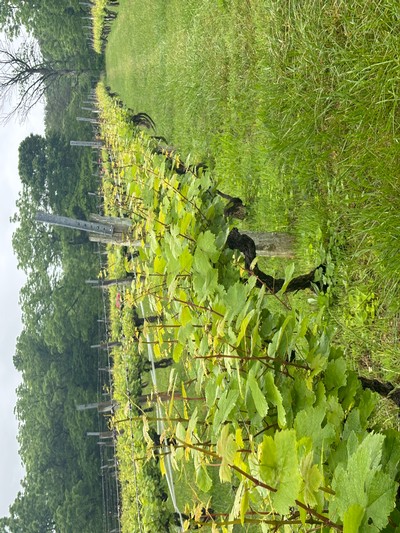
When Lew Parker first planted grapes at Willowcroft Farm Vineyards in 1980, there was no roadmap—only a dream, a hillside, and the hope that Virginia could one day rival the great wine regions of Europe. At the time, the very idea of growing European grape varieties, known as Vitis vinifera, was considered risky, even reckless, by local advisors from the Virginia Extension Service. But like many pioneers, Lew believed that the best way to grow was to take a chance.
The first vines planted, Cabernet Sauvignon, Riesling, Chardonnay, and Seyval, didn’t make it. A harsh introduction to the challenges of Virginia viticulture resulted in the entire initial planting failing. But that didn’t stop Lew. He replanted in 1981, and this second planting survived. Many of those vines continue to thrive today in our home vineyard, their deep roots telling the story of Willowcroft’s perseverance and vision.
Each variety chosen in those early days represented a bold step toward redefining what Virginia wine could be:
- Cabernet Sauvignon, a bold red grape from Bordeaux, was selected for its potential to bring structure and aging ability to Virginia reds.
- Riesling, a grape native to Germany’s cooler climates, offered aromatic white wine potential and acidity that could balance Virginia’s warmth.
- Chardonnay, the queen of white grapes, was a natural choice for producing elegant, versatile wines.
- Seyval, a French-American hybrid, provided insurance—hardier and more disease-resistant, Seyval could deliver reliable harvests when other vines struggled.
At the time, little was known about how to cultivate these varieties successfully in the unique microclimates of Virginia. It was all trial and error. The soil, slope, canopy management, and disease pressure were all things that had to be learned the hard way. But these early choices laid the foundation for what would become one of the most exciting wine regions in the country.
The decision to plant Vitis vinifera was a revolutionary one. Native American grapes and early hybrids had been cultivated in Virginia for centuries, but their wines were often considered musky, overly sweet, or lacking finesse. European settlers longed for the wines of home, and Vitis vinifera was the key.
Today, these European varieties make up more than 75% of Virginia’s grape production by tonnage. They have transformed the state’s reputation from a fledgling curiosity into a nationally recognized wine region with over 300 wineries. At Willowcroft, we continue to honor that legacy by producing high-quality vinifera wines—Cabernet Franc, Petit Verdot, Chardonnay, Albarino, and yes, still our original Cabernet Sauvignon and Riesling.
What makes those original plantings remarkable is not just their age—it’s their continued relevance. Despite decades of experimentation across the state, Cabernet Sauvignon, Chardonnay, and Riesling remain cornerstones of Virginia’s premium wine scene. These grapes have proven adaptable, expressive of Virginia’s terroir, and capable of producing wines with elegance, balance, and depth.
As for Seyval, it remains a staple at Willowcroft—a reminder that hybrid varieties have an essential place in our portfolio, offering resilience and versatility, especially as climate unpredictability increases.
Walking through the home vineyard today, you can still see those early vines—knotted, gnarled, and wise. They’ve weathered frost and sun, drought and deluge. And they still bear fruit that tells a story: of vision, of patience, and of a belief in Virginia’s potential before the rest of the world was ready to believe with us.
Willowcroft is proud to be the oldest winery in Loudoun County, a cornerstone of Virginia wine’s modern era. As we continue to innovate and expand our offerings, we never forget the vines that started it all—those planted not just in soil, but in hope.
Perfectly Imperfect: How to Embrace Faults and Find Your Favorite Wine
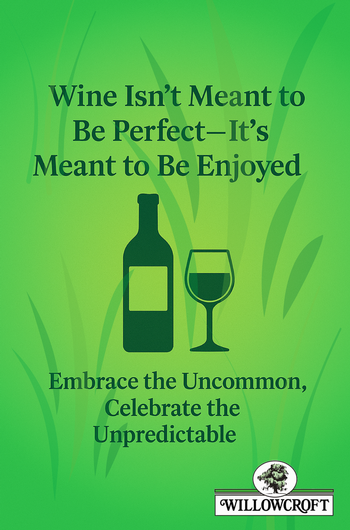 In the world of wine, perfection is elusive, which is precisely what makes it so captivating.
In the world of wine, perfection is elusive, which is precisely what makes it so captivating.
Much like people, every bottle of wine carries its own story, quirks, and character. Sometimes that story is rich and complex; other times, it’s a little offbeat. You may have heard terms like corked, oxidized, or reductive thrown around in tasting rooms or wine forums—but what do these so-called “faults” really mean, and should they scare you off?
Let’s uncork the truth.
A wine fault is typically defined as a chemical or microbial issue that deviates from what’s considered a “sound” wine. These can result from problems during winemaking, bottling, storage, or even cork taint. But here’s the catch: not all deviations are dealbreakers. In fact, some are simply nuances, and whether or not they bother you depends entirely on your palate.
Just like some people love blue cheese while others can’t stand it, wine “flaws” are often subjective. That little funky note or oxidative edge? It might just be what sets a wine apart in a way that makes you fall in love.
- Cork Taint (TCA): This one is pretty universally disliked—described as musty, moldy, or like wet cardboard. It mutes fruit flavors and makes the wine seem flat. If you encounter it, don’t feel bad about sending the bottle back or asking for a replacement.
- Oxidation: When a wine has been overly exposed to oxygen, it can taste like bruised apples or lose its vibrancy. But in some styles—think Sherry or older whites—oxidative notes are a feature, not a bug.
- Volatile Acidity (VA): A whiff of vinegar or nail polish remover can indicate high VA. While excessive VA can be jarring, a touch can actually enhance a wine’s complexity and brightness, especially in reds.
- Brettanomyces (“Brett”): This wild yeast brings earthy, leathery, or barnyard aromas. To some, it's rustic charm; to others, a flaw. Like spice in a dish, a little might be delicious—but too much can overpower.
- Reduction: The opposite of oxidation, reduction can smell like struck matches or rubber. Swirl your glass—often, those notes will dissipate, revealing layered, savory elements underneath.
Mouse is one of the more polarizing and, frankly, bizarre faults in wine. It's not something you smell—it’s something you feel after the sip, when the finish leaves your mouth tasting oddly like a hamster cage. Yes, really.
People describe it in creative (and colorful) ways: urine-soaked sawdust, old cured meats, or even “my teenage dog’s breath.” It’s most common in natural wines made without added sulfites and tends to emerge after the bottle has been open for a while, so a wine that seems fine at first might develop that off-putting flavor 30 minutes in.
Mouse is tricky because it’s not always present, and it’s not always immediately apparent. If you notice it, it’s usually best to move on to another wine, it's one of those faults that doesn’t fade away with food or time. Still, it’s a good reminder that even the most lovingly made wines can have quirks.
At Willowcroft, wine shouldn’t be intimidating—it should be an experience. Not every bottle will be perfect, but it might be perfect for you. And that’s what makes wine tasting so fun: every vintage, every varietal, every sip is an invitation to discover something new.
Whether you’re sipping a crisp Seyval on the porch or diving into a bold Bordeaux blend by the fire, remember: wine is meant to be enjoyed, not analyzed to death.
Next time something tastes a little different, don’t rush to judgment. Give it a swirl, give it a chance—and if it’s not for you, that’s okay too. There’s a world of wine waiting, full of character, depth, and maybe even a few charming flaws.
Like people, wine is rarely perfect, but it might be the perfect match for you.
What Are Wine Nuances? Discovering the Subtle Details in Every Sip
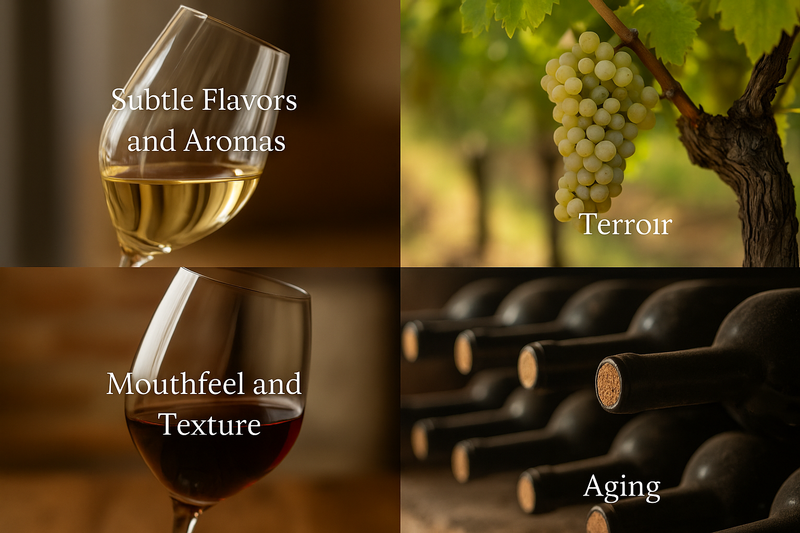
When wine lovers talk about “nuance,” they’re not just being poetic—it’s a real and important concept in the world of wine. Nuances are the fine details, delicate layers, and barely-there notes that make one wine stand apart. They’re the difference between a good glass of wine and one you can’t stop thinking about.
So what exactly are wine nuances, and how can you start to recognize them? Let’s explore.
Wine nuances refer to the subtle, intricate characteristics that give a wine depth and complexity. These aren’t the big, bold flavors you get on the first sip—they’re the supporting cast, the whispers behind the main melody. They might show up as a floral aroma that lingers for a moment, a hint of minerality on the finish, or a silky mouthfeel that softens the edges of a structured red.
These nuances show up in three main areas:
Most wines have dominant traits—citrus in a Sauvignon Blanc or dark fruit in a Cabernet. But nuanced wines go beyond that. You might detect:
- A trace of white pepper in a Syrah
- A honeysuckle note in a Viognier
- A whisper of vanilla or toast from oak aging
These aromas and flavors may not jump out immediately. Instead, they emerge gradually as the wine opens in the glass.
Nuance is often tied to terroir—the unique combination of soil, climate, elevation, and vineyard conditions where the grapes are grown. A Chardonnay grown in limestone-rich soil may reveal a chalky minerality, while the same grape grown in volcanic terrain might hint at smoke or flint.
These subtle variations can make the same varietal taste completely different from one vineyard to the next.
The physical sensation of wine in your mouth is a powerful (and often underrated) element of nuance. Consider:
- Silky or velvety tannins in a well-aged red
- A crisp, tingling acidity in a cool-climate white
- A creamy texture in a sur lie–aged Chardonnay
These textures can elevate a wine, adding refinement and polish to the experience.
With age, wines evolve—and so do their nuances. While a young wine may burst with fruit, an older wine often reveals tertiary characteristics like leather, dried herbs, forest floor, or nutty, oxidative notes. These flavors add richness, depth, and layers that make the wine far more complex than it once was.
Nuance can be complex to describe until you’ve tasted it, but here are a few examples to look for:
- A hint of vanilla from oak barrel aging
- A subtle spice note, like clove or cinnamon, in a red wine
- Minerality that reflects the soil in which the grapes were grown
- A delicate floral aroma, like jasmine or orange blossom
- A plush, silky mouthfeel from well-integrated tannins
Nuance is what turns wine from something we drink into something we experience. It invites us to slow down, sip again, and explore what’s in the glass. And while not every wine is meant to be deeply complex, recognizing nuance helps you become a more thoughtful, engaged wine drinker.
So the next time you pour a glass, take a moment to notice what’s beyond the first impression. You might discover something wonderful in the details.
Pride in Every Pour: Celebrating Innovation and Authenticity in Winemaking
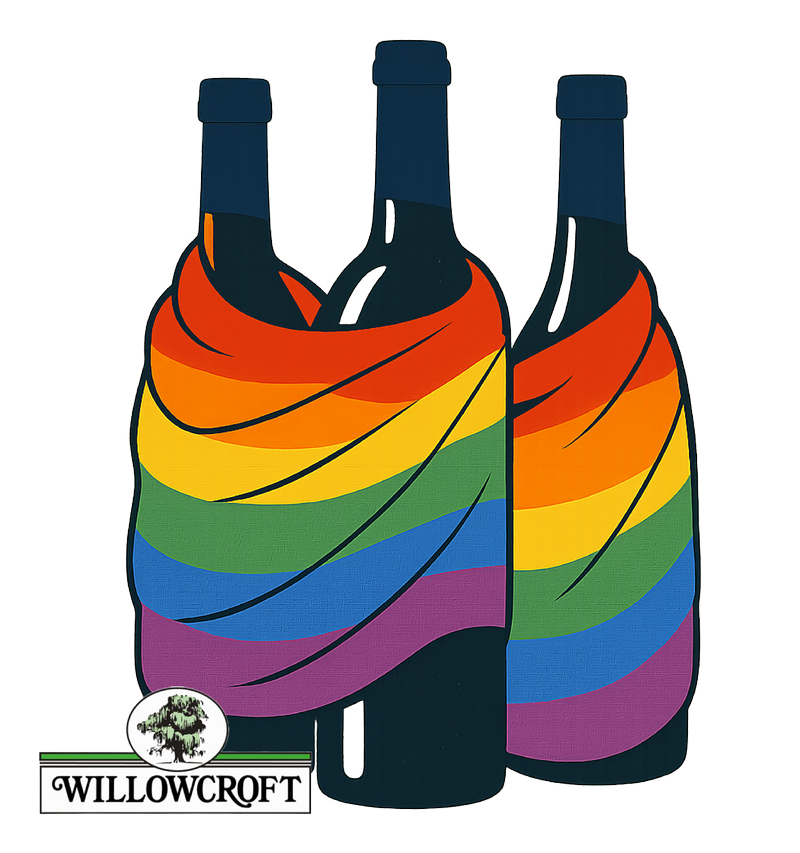 Forty years ago, Virginia's wine industry was in its infancy. Visionaries took bold steps, experimenting with grape varieties and viticultural practices to establish a now-thriving wine region. Today, a similar spirit of innovation and courage is evident among LGBTQ+ winemakers and vineyard owners who are reshaping the wine landscape with authenticity and resilience.
Forty years ago, Virginia's wine industry was in its infancy. Visionaries took bold steps, experimenting with grape varieties and viticultural practices to establish a now-thriving wine region. Today, a similar spirit of innovation and courage is evident among LGBTQ+ winemakers and vineyard owners who are reshaping the wine landscape with authenticity and resilience.
In wine—as in life—authenticity is everything. A growing number of winemakers are redefining what authenticity means, not just in the glass, but in how they show up for their communities, their land, and themselves.
Today’s LGBTQ+ winemakers are leading a quiet revolution, helping move the wine industry beyond traditional binaries—rejecting the tired “Old World vs. New World” narrative and instead forging a path rooted in diversity, regeneration, and inclusion. This isn’t just about identity—it’s about values. Winemakers like those at Kalchē Wine Cooperative operate on three guiding principles: diversity, equity, and regeneration. Their approach reflects a belief that justice—for people and for the planet—should be baked into the business of wine.
Theresa Heredia of Gary Farrell Winery exemplifies this vision. After leaving a Ph.D. program in chemistry to pursue her passion, she rose to national recognition as a nominee for Winemaker of the Year and helped foster a partnership with the Human Rights Campaign, ensuring that the fight for equality is toasted with nothing less than a beautifully crafted Pinot Noir.
Many of these winemakers embrace emerging varietals and experimental techniques while honoring the roots of tradition, like Remy Drabkin’s commitment to Italian grapes or Vivianne Kennedy’s work with minimal intervention wines. They are proving that innovation doesn’t mean abandoning heritage—it means expanding it to make room for everyone.
By embracing their full selves, these winemakers are changing the conversation. Their work inspires not because it’s different, but because it’s bold, honest, and deeply human, just like the best wines.
- Vivianne Kennedy – RAM Cellars (Oregon): As one of the few openly transgender winemakers in North America, Vivianne crafts natural wines that reflect both the terroir and her journey, emphasizing authenticity in every bottle.
- Remy Drabkin – Remy Wines (Oregon): A queer woman and founder of Remy Wines, Remy focuses on Italian varietals and co-founded Wine Country Pride to celebrate and support the LGBTQ+ community in rural Oregon.
- Terah Bajjalieh – Terah Wine Co. (California): A queer woman of color, Terah brings over a decade of global winemaking experience to her natural wine label, emphasizing organic and biodynamic practices.
- Jens Korberg & Bruno Francois – The Old Third Vineyard (Canada): Partners in life and business, they operate Canada's only LGBTQ-owned winery, producing unfined and unfiltered wines that express their commitment to authenticity.
- Mark Lyon – Eco Terreno Wines & Vineyards (California): An openly gay winemaker, Mark integrates sustainability with advocacy, supporting LGBTQ+ initiatives through his Sonoma County winery.
- Justine Belle Lambright – Kalchē Wine Cooperative (Vermont): A Black and queer co-founder, Justine leads a cooperative focusing on regenerative winemaking and inclusivity, challenging traditional norms in the industry.
- Theresa Heredia – Gary Farrell Winery (California): A passionate chemist-turned-winemaker, Theresa brings precision and heart to every bottle. She helped forge a partnership between Gary Farrell and the Human Rights Campaign, ensuring that every glass of her acclaimed Pinot Noir celebrates pride and purpose.
- Teneral Cellars (California): A woman-owned winery, Teneral Cellars exemplifies the fusion of quality winemaking and social advocacy. Their "Love is Love" Pride Collection features wines like the Overflowing with Pride Barbera and Loud and Proud Merlot. Notably, $10 from every 3-pack sold is donated to The Stonewall Inn Gives Back Initiative, supporting LGBTQ+ communities.
The creativity and courage shown by today’s LGBTQ+ winemakers echo the pioneering spirit that shaped Virginia’s wine industry decades ago. In both stories, we see people challenging assumptions about terroir, technique, or tradition and offering new expressions of what wine can be.
At Willowcroft, we understand the drive to do things differently. Our earliest vines were planted when Virginia was still an unproven region in American wine. It took vision, persistence, and a deep belief in possibility. That same spirit lives on in the work of winemakers who approach their craft with authenticity and pride, not as a statement, but as a standard.
Their commitment to regenerative agriculture, diverse leadership, and fresh perspectives is not a deviation from tradition—it’s a vital extension of it. Diversity in winemaking enriches the industry, expands our palates, and makes space for everyone to find a wine—and a story—that speaks to them.
As we reflect on the progress of Virginia's vineyards, we celebrate the LGBTQ+ individuals who continue to pioneer with pride and passion in the wine world. Their stories inspire us to appreciate the diversity and authenticity that make each bottle of wine a testament to resilience and innovation.
How Is Champagne Made? A Guide to Sparkling Wine Production Methods
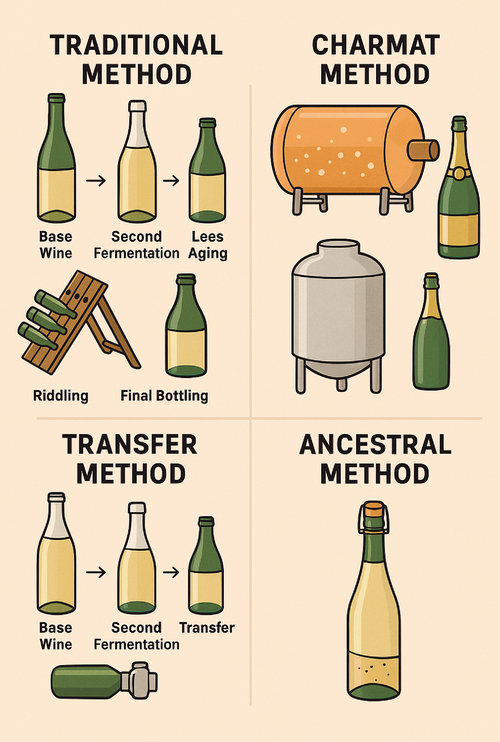
Sparkling wine is known for its festive bubbles, but not all fizz is created the same way. Champagne—arguably the world’s most iconic sparkling wine—is crafted using a time-intensive technique called the Traditional Method, or Méthode Champenoise. This process gives Champagne its signature fine bubbles, rich mouthfeel, and toasty, yeasty complexity.
But it’s not the only method. Let’s explore how sparkling wines are made, starting with the classic and moving through alternative worldwide techniques.
This is the most meticulous and respected method of making sparkling wine, used for Champagne, Crémant, Cava, and other premium wines.
- Step 1: Base Wine Production
Winemakers begin by creating a still (non-sparkling) wine from grapes, usually dry and high in acidity. These base wines are often blended from different vineyards, grape varieties, or vintages. - Step 2: Second Fermentation in Bottle
A mixture of sugar and yeast, called the liqueur de tirage, is added to the base wine, which is then sealed in individual bottles. This triggers a second fermentation, which produces carbon dioxide—the source of the bubbles. - Step 3: Lees Aging (Yeast Autolysis)
As the yeast cells finish fermenting the sugar, they die and settle inside the bottle, creating a layer of sediment known as lees. Wines are often aged on these lees for months or even years to develop richer textures and flavors like brioche, toast, and hazelnut. - Step 4: Riddling (Remuage)
Bottles are slowly tilted and rotated, traditionally by hand, to move the sediment down into the neck of the bottle. - Step 5: Disgorgement
The neck of the bottle is frozen, and the plug of frozen lees is ejected. The wine is topped up with a mixture of wine and sometimes sugar (called the dosage) to balance flavor before final sealing. - Step 6: Final Bottling and Labeling
The finished wine is corked, wired, labeled, and ready for enjoyment!
Not all sparkling wines are made using the traditional method. Here are a few other approaches:
- Charmat Method (Tank Method)
This method, used for Prosecco and many fresh, fruit-driven sparkling wines, carries out the second fermentation in a large, pressurized stainless steel tank rather than in individual bottles. It’s faster and less expensive, but it creates larger, less persistent bubbles and minimal yeast character. - Transfer Method
A hybrid of the traditional method, this approach starts with bottle fermentation, but the wine is then transferred to a tank, filtered, and rebottled. It’s more efficient and avoids riddling while retaining some lees influence. - Ancestral Method (Pét-Nat)
Short for Pétillant Naturel, this ancient method allows the wine to finish its fermentation in the bottle without added yeast or sugar. The result is a lightly sparkling, often cloudy wine that can be funky, unpredictable, charming, and fresh. - Continuous Method
This method, used less commonly today, involves continuous fermentation across several connected tanks, creating a steady stream of sparkling wine.
The method used to produce a sparkling wine significantly impacts the final experience in your glass. While the Traditional Method creates wines with finer bubbles and more complex flavors, other methods can produce fun, fresh wines perfect for casual sipping.
Whether you're popping Champagne for a celebration or toasting with a bright glass of Prosecco on the patio, knowing how your bubbles are made can deepen your appreciation—and guide you to styles you’ll love.
What Is Sur Lie Aging? Understanding Wine on the Lees
From vineyard grapes to lees stirring and aging in barrel, sur lie winemaking builds richness, texture, and complexity in the final glass.
If you've ever noticed the words “sur lie” on a wine label and wondered what it means, you're not alone. This French term—translating to “on the lees”—refers to a winemaking technique that plays a powerful role in shaping a wine’s texture, flavor, and aging potential. In this post, we’ll explore what sur lie aging is, how it works, and which wines shine brightest with this process.
“Sur lie” means that the wine was aged on its lees—tiny, natural particles of dead yeast cells and grape solids left over after fermentation. Rather than filtering these out immediately, winemakers allow the wine to rest on them for an extended period, often weeks to several months, and sometimes longer.
This aging can occur in stainless steel tanks, neutral barrels, or even oak, and may involve periodic stirring of the lees (a technique called bâtonnage) to increase contact between the wine and these sediments.
Lees aging has a noticeable and desirable impact on both texture and flavor:
- Mouthfeel: Wines aged sur lie tend to feel richer and creamier. The breakdown of yeast cells releases compounds that create a rounder, silkier texture.
- Flavor: This process can introduce subtle notes of brioche, toasted nuts, yeasty richness, and sometimes a savory or smoky nuance. These flavors are especially welcome in wines that might otherwise lean sharp or acidic.
- Aging & Stability: Sur lie aging can also help stabilize a wine and extend its aging potential by protecting it from oxidation and allowing more complexity to develop over time.
This technique isn’t used for all wines, but for specific varietals and styles, it can be transformative. Some of the most commonly sur lie–aged wines include:
- White wines: Chardonnay, Muscadet, Chenin Blanc, Albariño, and Pinot Blanc are frequent candidates. The technique softens acidity and adds layers of flavor to crisp whites.
- Sparkling wines: Traditional-method sparkling wines (like Champagne or Crémant) are aged extensively on lees, often for years, contributing to their signature toasty, biscuit-like aromas.
- Occasional reds: Though less common, some red wines—especially Pinot Noir or select natural wines—may also spend time on lees to soften tannins and add body.
If you’re looking to explore sur lie–aged wines, start with these key regions and styles:
- Loire Valley, France – Especially Muscadet Sèvre et Maine, a classic sur lie white.
- Burgundy, France – Many high-quality Chardonnays undergo sur lie aging, particularly from Meursault and Puligny-Montrachet.
- Spain – Albariño from Rías Baixas is often aged on lees for texture and depth.
- Oregon and California – U.S. Chardonnays and some Chenin Blancs frequently use this method.
- South Africa & Australia – Innovative winemakers increasingly use lees contact for complexity in whites and sparklings.
It’s important to note that sur lie aging is a tool, not a magic fix. While it can enhance good wine—adding depth, softness, and character—it won’t repair flaws caused by poor vineyard practices or fermentation issues. If mismanaged, lees contact can create off-flavors or murkiness. Winemakers must monitor the process carefully to get the balance right.
Sur lie aging is a natural, time-tested technique that gives wines a richer texture and greater complexity. Whether it’s a creamy Chardonnay or a crisp Muscadet with a subtle yeasty note, wines aged on their lees offer an added dimension that can elevate your tasting experience. So next time you spot “sur lie” on a bottle—or notice those nutty, toasty flavors in your glass—you’ll know exactly why.
How Climate Shapes the Wines We Love: A Look at Four Unique Regions
If you’ve ever wondered why a Chardonnay from California tastes so different from one grown in Virginia or New York’s Finger Lakes, the answer often lies in one word: CLIMATE.
From the first bud break in spring to the final harvest in fall, a wine region's climate profoundly shapes the grapes it grows and the wine it ultimately produces. Understanding how climate influences wine is a fascinating way to deepen your appreciation for each glass.
- Warm climates promote faster ripening, leading to grapes with higher sugar content and lower acidity and typically more intense, full-bodied wines with higher alcohol and lush, ripe fruit flavors.
- Cool climates slow the ripening process, resulting in grapes with higher acidity and lower sugar and wines that are lighter, brighter, and often more nuanced.
But there’s more to climate than just temperature. Let’s explore some other key factors—and how they play out in a few distinct U.S. wine regions, including our home here in Virginia.
Sunlight is essential to photosynthesis and sugar development in grapes, but balance is key.
- Too little sun? Grapes may not fully ripen.
- Too much? Sunburned fruit and imbalanced wines.
Virginia's warm summer days and cool mountain nights give us the perfect mix, particularly atop the Catoctin Ridge where our vineyards are perched. That diurnal shift preserves acidity and builds complexity in grapes like Cabernet Franc and Albarino.
California, particularly in Napa or Paso Robles, experiences more intense, consistent heat and sun. This translates to wines with bolder body, ripe fruit flavors, and typically higher alcohol levels—think classic California Cabernet Sauvignon or Zinfandel.
Rain and humidity can make or break a vintage.
- Too much rainfall close to harvest? Grapes swell and lose concentration.
- High humidity increases disease risk, especially for tightly clustered grapes like Riesling or Chardonnay.
The Finger Lakes region in New York experiences a short growing season and cooler, often wetter conditions. But the lakes themselves help moderate the climate, making the area ideal for high-acid, aromatic whites like Riesling and Gewürztraminer.
New Mexico, where we’ve recently partnered for special tastings, is a high-elevation, semi-arid wine region. With ample sunshine and low humidity, grapes ripen well while maintaining freshness, particularly important for varietals like Syrah, Tempranillo, and sparkling wine grapes.
As global temperatures rise, winemakers around the world are being challenged to adapt:
- Earlier ripening can mean unbalanced sugar and acid levels.
- Shifts in suitability lead to new wine regions emerging, while traditional ones are being pushed to evolve.
At Willowcroft Farm Vineyards, we stay informed and nimble, choosing disease-resistant rootstocks, using canopy management to optimize sun exposure, and continually evaluating what grows best in our changing climate. Our recent addition of Albarino is one such adaptation—and it’s been a thrilling success.
From the rolling hills of Virginia to the dry elevations of New Mexico, the sun-soaked vineyards of California, and the cool, lake-influenced slopes of New York, climate gives every region its signature. For wine lovers, understanding these differences isn’t just educational—it’s delicious.
So next time you swirl a glass, consider the climate story behind it. It might just change the way you taste.
Bold Reds Meet Plant-Based Plates: Vegetarian & Vegan Pairings with Willowcroft Wines
When people think of bold red wines, they often imagine them alongside rich meats—steaks, burgers, lamb. But what if you’re living a vegetarian or vegan lifestyle? Great news: you don’t need meat to enjoy a bold red. At Willowcroft Farm Vineyards, we’ve found that our robust reds pair beautifully with creative plant-based dishes. With a bit of flavor strategy, these wines can shine alongside your favorite meatless meals.
Let’s start with a few of Willowcroft’s boldest red wines:
- Petit Verdot – Deep, dark, and structured, with notes of blackberry, violet, and spice.
- Cabernet Sauvignon – A full-bodied red with black fruit character, tannin, and hints of toasted oak.
- Cabernet Franc – Medium to full-bodied, with savory herbaceous notes, cherry, and soft pepper spice.
- Chambourcin – Lush and fruit-forward, with earthy undertones and a smooth, juicy finish.
- Merlot – Soft yet rich, offering plum, cherry, and a touch of chocolate.
- Mushroom Wellington with Cabernet Franc
The earthiness of mushrooms paired with flaky pastry makes this dish rich and savory. Cabernet Franc brings out the umami and adds a bit of lift with its natural acidity and herbal edge. For extra depth, include shallots and a red wine reduction in your filling. - Smoky Lentil & Walnut Bolognese with Petit Verdot
This hearty, smoky vegan sauce doesn’t need meat to be bold. Lentils, tomatoes, and walnuts simmered with garlic and smoked paprika create a satisfying texture and depth that match Petit Verdot’s dark fruit and spice. - Eggplant Parmesan (Dairy-Free) with Cabernet Sauvignon
Whether you go traditional or gluten-free, this veganized version of a classic Italian dish holds up to a structured Cab. The acidity of the tomato sauce balances the tannins, while the eggplant’s texture stands up to the wine’s boldness. - Vegan BBQ Jackfruit Sandwich with Chambourcin
Chambourcin’s ripe fruit and slight earthiness complement the tangy, smoky BBQ flavor of jackfruit. Add a crunchy slaw and serve on a toasted bun for a laid-back but delicious pairing. - Grilled Portobello & Veggie Skewers with Merlot
Grilling brings out the sweetness in vegetables like bell peppers, onions, and zucchini, while portobellos add chew and umami. Merlot’s round body and smooth tannins harmonize well, making for a balanced and flavorful meal.
Pairing bold reds with vegetarian and vegan dishes is all about focusing on depth of flavor, texture, and umami elements. Roasted, grilled, or smoked ingredients tend to perform best. With Willowcroft’s versatile selection of red wines, you’re never limited by your diet—only by your imagination.
Come visit us to taste these wines and discover even more plant-based pairings. Whether you’re a full-time vegan or just trying something new, a bold Willowcroft red is waiting for you.
🍷 Cheers to flavor without compromise!

